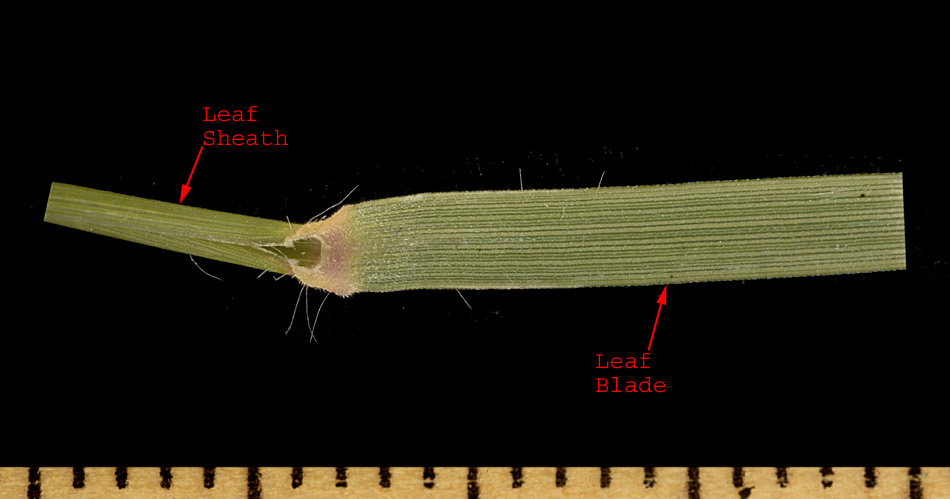 | Multitribe: Answers to key questions
leading to this tribe.
 | Mature inflorescence, if breaking into units, then the units not as
below; NOT [Mature inflorescence breaking into spikelet units consisting
of a sessile fertile spikelet, a hairy pedicel with or without a sterile
spikelet at tip, and a hairy rachis joint, all arising at the same point
(a node) in specialized panicle branches called rames] |
 | Spikelets not as below; sterile florets if present, either located
distal to the fertile floret(s) on the rachilla or paired and attached
at the base of a single fertile floret, not paired with the upper glume
as below; lemma and palea variously textured, enclosing the flower or
not; disarticulation usually above the glumes; NOT [Spikelets usually
dorsally compressed, appearing 1-flowered but containing 1 fertile
floret and 1 sterile floret, the latter attached to the base of fertile
floret opposite the upper glume, resembling the upper glume, and
together with the upper glume enveloping the fertile floret; lower
glumes minute (sometimes absent) to 3/4 as long as upper glumes and
typically wrapping most of the way around the pedicel at base; fertile
floret seed-like with chartaceous-indurate lemma and palea enclosing
flower and fruit; disarticulation below the glumes with rare exceptions] |
 | Spikelets 1 to many-flowered, subtended by a pair of glumes (only 1 on
lateral spikelets in Lolium); palea margins enclosed or not; plants of
dry or wet habitats; NOT [Spikelets 1-flowered, lacking glumes; margins
of the palea tightly enclosed by the lemma margins on female or perfect
florets; plants of wetlands, often emergent aquatic] |
 | Inflorescence not as below; if a terminal spike, then the lateral
spikelets attached edgewise to the rachis with inner (upper) glume
wanting (as in Lolium); NOT [Inflorescence a terminal spike with sessile
or subsessile spikelets attached broadside at nodes on opposite sides of
the rachis] |
 | Lemmas and lemma awns not as below; if lemma indurate and enveloping
the floret, then glumes distinctly dorsally compressed and calluses
glabrous (as in Milium); NOT [Lemmas stiff to indurate, firmer than the
glumes, surrounding the palea and often overlapping along the margins,
closed at the tip as well as at the base, often pubescent; lemma awns
(caducous or wanting in some species) terete and encircled at the base
by the closed tip of the lemma; calluses usually pubescent, rarely
glabrous]
|
|
 | Group1: Answers to key questions
leading to this group.
 | If plants mat-forming, then inflorescences not as below; NOT
[Mat-forming annuals or perennials either with clusters of spikelets
hidden by sharp-pointed leaves at branch tips, or with pistillate
inflorescences consisting of burs partially hidden within expanded leaf
sheaths with only the staminate inflorescences exceeding the upper
leaves] |
 | Inflorescence consisting of spike-like panicle branches with sessile-
subsessile, closely imbricate, regularly-spaced, parallel spikelets all
directed toward 1 side of the branch like the teeth of a comb (loosely
so in Bouteloua curtipendula); fertile florets 1 per spikelet; NOT
[Inflorescence not as above, the spikelets usually on pedicels in
panicles that range from spike-like to open; if spikelets sessile, then
they either have more than 1 fertile floret per spikelet or are not
arranged like the teeth of a comb]
|
 | Bouteloua: Answers to key questions
leading to this genus.
 | Glumes unequal, the lower glume distinctly narrower and shorter than
the upper glume, upper (exterior and longer) glume (2.5) 3.5-25 mm long;
ligules <= 3 mm long, a fringe of hairs with or without a membranous
base; NOT [Glumes subequal, D-shaped in side view, about 3 mm long;
ligules 5-11 mm long, membranous, entire or lacerate] |
 | Plants slender, 0.7-8 dm high; rhizomes absent or slender; panicle
branches erect to reflexed; upper glumes (2.5) 3.5-8 mm long; lemma apex
with 3 excurrent nerves or 3 awns up to 6 mm long; ligules up to 0.5 mm
long; NOT [Plants coarse, 3.5-20 (25) dm high; rhizomes present and
thick (1.5-8 mm wide); panicle branches erect to ascending; upper glumes
6-25 mm long; lemma apex unawned, obtuse to slightly rounded, sometimes
lobed at tip; ligules 0.5-3 mm long]
|
|
 |
Gracilis: Answers to key questions
leading to this species
 | Culms with 1-3 (6) panicle branches, these terminating in a spikelet;
spikelets (20) 40-130 per branch; anthers yellow or purple;
disarticulation above the glumes; culms tufted, often sod-forming,
rhizomes, if present, short; NOT [Culms with more than 6 (usually
>20) panicle branches, these terminating in a 3-5 mm long point
rather than a spikelet; spikelets fewer than 7 (15) per branch; anthers
usually red to red-orange; disarticulation at base of branches; culms
solitary or in small groups from long rhizomes] |
|
|

